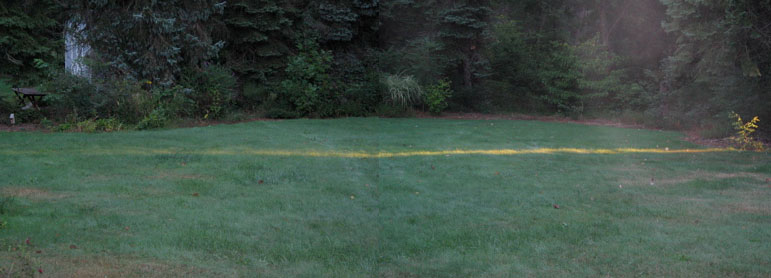![]() Observation: The First Step in the Scientific Method
Observation: The First Step in the Scientific Method
To observe means to look at something carefully and to notice the details. When people observe things they
often wonder why it is that way. Scientists work to answer that question. They make observations as the first
step to the scientific method.Observations are also called data. There are two kinds of data.
Qualitative data are descriptions that do not have numbers.
It is very bright outside, is an example of qualitative data.
Quantitative data are obtained by measuring and have numbers. Scientists use instruments (tools) to obtain numeric data.
The student's light meter read 30,000 lux, on the playground at 1200 hours is quantitative data.
It is important to be a careful observer. The smallest detail can be important to finding the answer to a question.
Practice observing by looking at this photo. I saw this phenomena in my backyard on 09/16/2007 at 0615.
(Please note the line was one continuous line. I was not successful in photographing that. My son used Photoshop to stitch the photos together)Facing North
Click here for a closer view. Use the Back Button of your browser to return to this web page.
1. Write your observations - one per line - on a piece of paper.
2. Imagine - If you were standing in the scene:
What tools (instruments) would help you to be a better observer?
What tools (instruments) might you use to measure what you are observing?
3. Fire up your imagination or curiosity.
Write at least two hypothesis about what you have observed. (What is a hypothesis?)
4. Predict - Do you expect that this phenomena will remain visible all day?
Will it be visible at night? Explain your prediction.
Explore more:
About Units of Measurement - IB Biology | Observing Biology how to's | Temperature facts and figures - IB Biology
Steps of the Scientific Method - Science Buddies | Learn about the Scientific Method
"The young specialist in English Lit, ...lectured me severely on the fact that in every century people have thought they understood the Universe at last, and in every century they were proved to be wrong.
It follows that the one thing we can say about our modern "knowledge" is that it is wrong." Isaac Asimov
Light Phenomena Internet Hunt | Winter's Story | Bluebirds Project | Energy and Alternative Energy Studies
![]()
All trademarks, copyright and logos belong to their respective owners.
Internet Hunts / Nature / Water Studies / Computers / Famous Pennsylvanians / Civics / Puzzles & Projects / Site map / Home
FAQ Posted
by Cynthia J. O'Hora 9/2007, released for noncommercial use by nonprofit organizations
Aligned
with Pennsylvania Academic Standards | Assessment and Rubrics
![]() Save a tree - use a Digital Answer Format - Highlight the text. Copy it. Paste it in a word processing document. Save the document in your folder. Answer on the word processing document in an easily read, contrasting color or font. (Not yellow ) Avoid fancy fonts like Symbols, Techno,
Save a tree - use a Digital Answer Format - Highlight the text. Copy it. Paste it in a word processing document. Save the document in your folder. Answer on the word processing document in an easily read, contrasting color or font. (Not yellow ) Avoid fancy fonts like Symbols, Techno, ![]() fonts). Save frequently as you work. I have never liked losing my work. You will not like it either. Be sure to enter your name & the date at the top of the document. Submit via email attachment or class dropbox. Bad things happen: Save a copy of the response document for your records.
fonts). Save frequently as you work. I have never liked losing my work. You will not like it either. Be sure to enter your name & the date at the top of the document. Submit via email attachment or class dropbox. Bad things happen: Save a copy of the response document for your records.
Proof your responses. It is funny how speling errors and typeos sneak in to the bets work. ![]() Make your own printer paper answer sheet
Make your own printer paper answer sheet
